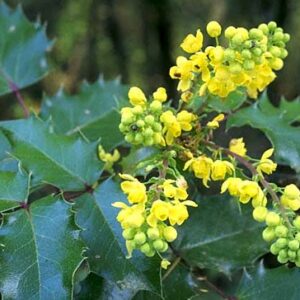Showing the single result
Wholesale Oregon Grape Bush in Michigan
Cold Stream Farm is a Michigan-based supplier of Oregon Grape Bush plants. We sell Oregon Grape bare root seedlings and transplants at retail and wholesale prices with no minimum order required.
We proudly carry limited Oregon Grape bush (Mahonia aquifolium) plants that are primarily available in the spring. Shipments can be arranged for orders throughout the United States, with restrictions on Canadian imports.
About Oregon Grape Bush (Mahonia aquifolium)
Oregon Grape bush (Latin name Mahonia aquifolium) is a fruit-bearing plant native to the American Pacific Northwest from California to British Columbia. The plant derives its common name from the state of Oregon (where it is the state flower) and its Latin name from the American horticulturist Bernard McMahon.
Other common names for Oregon Grape Bush include:
- Oregon-Grape
- Oregon-Grape Plant
- Tall Oregon-Grape
- Grape Holly
- Hollyleaf Barberry
Size, Shape, and Appearance
An Oregon Grape Bush grows to be approximately 6 feet tall and 5 to 6 feet wide. Mahonia aquifolium is characterized by having evergreen holly-like leaves, yellow flowers, and purple-blue fruit.
It is easy to recognize an Oregon Grape bush with its “toothish” leaves complemented by bright blooms and bunches of grapes. Technically, the Oregon Grape bush is in the Berberidaceae family which makes it separate from both true grapes and true holly plants.
Typical Oregon Grape bush flowers will bloom in late spring. A few months later, the berries will begin to grow in June and are usually ripe for picking in the fall. Oregon Grape trees are evergreen, and thus provide colorful texture to an outdoor space all year long.
Best Growing Conditions
Oregon Grape bushes are ideally suited for USDA Zones 5 through 9. The plants prefer partial sunlight and are very adaptable to dense shade conditions. Although they can survive with full sun, some Oregon Grape bushes may become damaged from too much direct sunlight.
The ideal soil for growing Oregon Grape bushes is slightly acidic, rich in hummus, and able to provide even moisture to the plant’s roots. Alkaline soils can be potentially dangerous to Oregon Grape plants and systems should have sufficient draining systems.
Uses for Oregon Grape Bushes
Bulky and naturally deer resistant, Oregon Grape Bushes are great for hedges and barriers. Mature plants are typically very rugged, although protection from winter winds may be necessary to keep bushes thriving.
Functional and beautiful, Oregon Grape Bushes are often planted ornamentally. Often, they are used as a substitute for English Ivy or another invasive species. The berries are also edible and can be consumed by animals and people alike.
Eaten raw or prepared, Oregon Grape bush fruit is common for jams, jellies, and simply picking off the vine. However, it is important to note that the fruit may be toxic to infants and should be avoided by newborns and pregnant women.
Ecology and Wildlife
Oregon Grape bushes attract and provide food for many species of birds, bees, and other small fauna. The plant is naturally good at attracting hummingbirds and butterflies and thus is a popular garden feature.
Aside from sustenance, Oregon Grape trees also provide shelter all year long for small mammals, reptiles, and other critters. Some species of moths and butterflies use Oregon Grape bushes to nest their larva on the plant’s leaves.
Common Issues
Attracting much more than just birds and bees, Oregon Grape bushes are also subject to visits from many unwanted pests that can potentially damage or kill entire plants. Most commonly, mold and honeydew left behind by scales, aphids, and whiteflies can cause infractions and diseases in Oregon Grape plants.
Semi-regular analysis of an Oregon Grape bush is recommended, checking for damage from pests or over-exposure. If “sun-spots” have been burnt into the leaves, an Oregon Grape plant may need to be transplanted to a shadier area.
How to Maintain Your Oregon Grape Bushes
Compared to other plants, Oregon Grape bushes are not very demanding. Adaptable to most light and soil conditions, Oregon Grape bushes are an easy way to grow attractive-looking plants that bear delicious fruit.
For the best results, it is recommended that gardeners prune their Oregon Grape bushes just after the plant has finished blooming. Doing so will allow the maximum amount of fruit to grow and thrive. Once the fruit has ripened, fall is also a great time of year to take trimmings for further propagation.
Oregon Grape plants may propagate naturally by cloning themselves directly on your property. If you are looking for expansion, it is easy for Oregon Grape plants to reproduce, which may make them considered an invasive species in some parts of the world.
Get Started with Wholesale Oregon Grapes
Cold Stream Farm has no minimum order on retail and wholesale purchases of Oregon Grape transplants and bare root seedlings. Our Oregon Grape Bush stock is limited, but plants may be available. Order online or contact us today to get started today.


